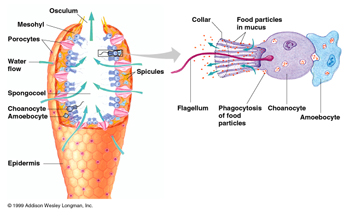The sponge has no nervous system, digestive system, or circulatory system. They rely on maintaining a constant flow of water through their bodies to get food and oxygen and get rid of waste products. the cells on the wall of the sponge filter food from the water as it is pumped through the body and vesicles (the "small mouth"). The sponge has no actual circulatory system. The sponge has flagellar cells on the surface of the body. These are cells whose tails sway. The collective effort of all these cells creates a stream of water through the many porous openings in the sponge body. It is a water-based circulation system. All sponges are aquatic and most of the species are marine. The sponge lives in close contact with water, which plays a role in food, gas exchange and excretion. Many of the sponge's body structures are dedicated to the movement of water through the body, allowing it to filter food, absorb dissolved oxygen, and eliminate waste products. The cells of the sponge also diffuse other soluble waste such as carbon dioxide and ammonia. Choanocytes have a sticky funnel-shaped collar and a hair-like whip called flagella. Choanocytes serve two purposes. First, they tap the flagella back and forth to force water through the sponge. Water takes in nutrients and oxygen and carries waste products and carbon dioxide.
study.com Изображение: study.com Water circulates in the sponge body with the help of cells called choanocytes. These cells contain the flagella that move the water in the sponge. When the water is removed, food and oxygen are carried to the sponge.
How does the circulatory system of the sponge work?
The sponge does not have a true circulatory system, but the system uses running water instead. The gas is carried into the cell by electric current and enters the cell by diffusion. Archaea supply nutrients.
What is the function of water in the sponge?
Water is the basis for the circulation of nutrients and food particles throughout the body cavity of sponges. Since the sponge does not have a true circulatory system, water pushes nutrients and gas through the sponge koel and through the oscrum.
How does a calcareous sponge absorb oxygen?
Limestone sponge. The cells of the sponge absorb oxygen by diffusion from a water flow system that also diffuses other soluble wastes such as carbon dioxide and ammonia. Archaea remove mineral particles that can block the pores, transport them through the mesohyl, and normally release them into the outflow of water
Sponge choanocytes function What is ?
Colors all peach or pink epithelial cells (B) in the epidermis. The inner layer is composed of choanocytes (A), which have the function of circulating water through the sponge. They do this by drawing water through the current interstitial water and then shaking the bristles leaving the oscram at the top of the sponge.
How does the sponge breathe, circulate and excrete?
All other major physical functions (gas exchange, circulation, excretion) within the sponge are due to diffusion between the cells that line the openings in the sponge and the water that passes through those openings. It will be executed. All cell types in the sponge get oxygen from water by diffusion.
How does a sponge move water into the body?
To get food, sponges allow water to pass through their bodies in a process known as filter feeding. .. Through larger pores called outflow pores through which water exits. Bacteria and small particles are absorbed from the water as food as they pass through the waterways and chambers inside the sponge.
How is the sponge excreted?
There is no sponge in the respiratory system. Oxygen is supplied by a direct exchange between the tissue and the surrounding water. Excretion occurs from both the surface of the oscula and the sponge. Special amoebic cells collapse in the mesohyl and their granules are excreted from the canal.
How does the sponge breathe?
Instead, the sponge has a simple body covered with pores, and inside the pore layer is a tissue-like material called mesohyl This process of breathing through the water cycle is called diffusion because it diffuses into the body through the water that oxygen flows into.

Below you will find two helpful answers on a similar topic. 👇
How can a sponge survive without a circulatory system?Is Picasso considered a master?
